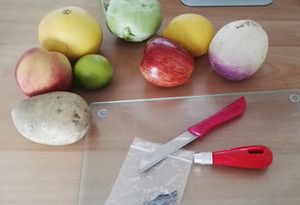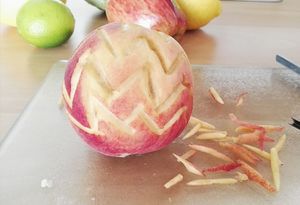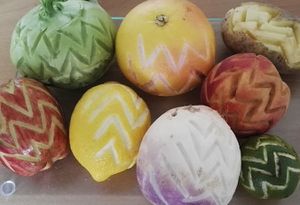Difference between revisions of "User:Simonevdw"
| Line 22: | Line 22: | ||
Ruskin was extremely prolific. He is remembered primarily as an artist and art critic, and as a social thinker, but he also produced poetry and fiction, and wrote about architecture, geology, literature, science, and the environment. It is his ideas about art and society, and his critique of the dehumanized model of industrial production which we will focus on here. John Ruskin was not a central participant in the Arts and Crafts Movement, English or American, but was an inspirational harbinger of its coming and a major influence on its proponents. For example, William Morris, often called the father of the Arts and Crafts Movement, admired Ruskin and was strongly influenced by his writings and social commentaries. Years after being introduced to Ruskin's works, Morris recalled it and stated, "To some of us when we first read it, now many years ago, it seemed to point out a new road on which the world should travel." | Ruskin was extremely prolific. He is remembered primarily as an artist and art critic, and as a social thinker, but he also produced poetry and fiction, and wrote about architecture, geology, literature, science, and the environment. It is his ideas about art and society, and his critique of the dehumanized model of industrial production which we will focus on here. John Ruskin was not a central participant in the Arts and Crafts Movement, English or American, but was an inspirational harbinger of its coming and a major influence on its proponents. For example, William Morris, often called the father of the Arts and Crafts Movement, admired Ruskin and was strongly influenced by his writings and social commentaries. Years after being introduced to Ruskin's works, Morris recalled it and stated, "To some of us when we first read it, now many years ago, it seemed to point out a new road on which the world should travel." | ||
| − | In truth, the mid 19th century writings of John Ruskin laid the foundations for many of the craftsman style values of the Arts and Crafts Movement. His writings predicted and commented on social issues such as environmentalism, sustainability, craftsmanship, and fulfilling labor. Most importantly for the Arts and Crafts Movement to come, Ruskin called for a revival of traditional craftsmanship and a return to the spiritual values of handcrafting from natural materials. | + | In truth, the mid 19th century writings of John Ruskin laid the foundations for many of the craftsman style values of the Arts and Crafts Movement. His writings predicted and commented on social issues such as '''environmentalism, sustainability, craftsmanship''', and fulfilling labor. Most importantly for the Arts and Crafts Movement to come, Ruskin called for a '''revival of traditional craftsmanship and a return to the spiritual values of handcrafting from natural materials.''' |
Two of his most influential works, The Seven Lamps of Architecture (1849) and The Stones of Venice (1851-53, a trilogy), addressed the subjects of nature, art, society, and skilled craftsmanship, and attacked division of labor (industrialized workforce specialization) and industrial capitalism. Such topics are truly close to the heart of the Arts and Crafts Movement. | Two of his most influential works, The Seven Lamps of Architecture (1849) and The Stones of Venice (1851-53, a trilogy), addressed the subjects of nature, art, society, and skilled craftsmanship, and attacked division of labor (industrialized workforce specialization) and industrial capitalism. Such topics are truly close to the heart of the Arts and Crafts Movement. | ||
Revision as of 13:28, 16 April 2016
Making is connecting Simone van de Werken - 0894623@hr.nl
Contents
Notes on texts
The meaning of making: philosophies of craft
What is craft?
Craft might suggest the careful work of a woodcarver of ceramicist, a skilled practice of making beautiful objects. The term might be associated with traditional and rather twee items wich you might have seen on sale at craft fairs, or it might suggest a newer, cool approach to making things yourself, as seen in the recent rise of knitting, craft fairs, DIY culture, and other trendy craft activities. The term ‘craft’ is further complicated by its relationship with art. Somehow the concepts are still separate:
Art tends to mean the truly creative transformation of ideas and emotions into visual objests. Craft having been shoved out of that space – ends up indicating the less prestigious production of carving or pots, by less creative people who just like doing it.
People see art as superior, and instead to regard its stance as unnecessarily pretentious and exclusive, and therefore rather silly, in comparison to the more earthy, engaged spirit of craft. There is still, of course, the problem that this may not be the majority or dominant view.
John Ruskin
Ruskin was extremely prolific. He is remembered primarily as an artist and art critic, and as a social thinker, but he also produced poetry and fiction, and wrote about architecture, geology, literature, science, and the environment. It is his ideas about art and society, and his critique of the dehumanized model of industrial production which we will focus on here. John Ruskin was not a central participant in the Arts and Crafts Movement, English or American, but was an inspirational harbinger of its coming and a major influence on its proponents. For example, William Morris, often called the father of the Arts and Crafts Movement, admired Ruskin and was strongly influenced by his writings and social commentaries. Years after being introduced to Ruskin's works, Morris recalled it and stated, "To some of us when we first read it, now many years ago, it seemed to point out a new road on which the world should travel."
In truth, the mid 19th century writings of John Ruskin laid the foundations for many of the craftsman style values of the Arts and Crafts Movement. His writings predicted and commented on social issues such as environmentalism, sustainability, craftsmanship, and fulfilling labor. Most importantly for the Arts and Crafts Movement to come, Ruskin called for a revival of traditional craftsmanship and a return to the spiritual values of handcrafting from natural materials.
Two of his most influential works, The Seven Lamps of Architecture (1849) and The Stones of Venice (1851-53, a trilogy), addressed the subjects of nature, art, society, and skilled craftsmanship, and attacked division of labor (industrialized workforce specialization) and industrial capitalism. Such topics are truly close to the heart of the Arts and Crafts Movement.
Experiments
Etching
Etching is traditionally the process of using strong acid or mordant to cut into the unprotected parts of a metal surface to create a design in the metal. I really wanted to try this method for a pretty long time, and i thought now was the perfect opportunity. It is a method of print making, but i feel like the copper plate itself is already very special. I love how the plates of old master pieces often still exist because the material will last very long.
History of the technique:
The process as applied to printmaking is believed to have been invented by Daniel Hopfer (circa 1470–1536) of Augsburg, Germany. Hopfer was a craftsman who decorated armour in this way, and applied the method to printmaking, using iron plates (many of which still exist). Apart from his prints, there are two proven examples of his work on armour: a shield from 1536 now in the Real Armeria of Madrid and a sword in the Germanisches Nationalmuseum of Nuremberg. An Augsburg horse armour in the German Historical Museum, Berlin, dating to between 1512 and 1515, is decorated with motifs from Hopfer's etchings and woodcuts, but this is no evidence that Hopfer himself worked on it, as his decorative prints were largely produced as patterns for other craftsmen in various media.
The switch to copper plates was probably made in Italy, and thereafter etching soon came to challenge engraving as the most popular medium for artists in printmaking. Its great advantage was that, unlike engraving where the difficult technique for using the burin requires special skill in metalworking, the basic technique for creating the image on the plate in etching is relatively easy to learn for an artist trained in drawing. On the other hand, the handling of the ground and acid need skill and experience, and are not without health and safety risks, as well as the risk of a ruined plate.
What i did:
Before i started i had to prepare my plate. I had to use fine steel wool and a piece of cloth and rub copper oil on to the plate till the surface was super shiny and smooth. With a hand file i beveled the edges of the plate. This is because otherwise the sharp edges can damage the paper when it goes trough the press. After that i degreased the plate. I did that with soy sauce and a piece of spunge. Then i washed the plate under running water, and put it in an oven for a few minutes to dry.
I first tried the basic method. I used wax to cover the plate, baked it in the oven and scratch that off. Then i had to soak the plate in acid so it was engraved because the parts that are not covered with wax will dissolve. I also used the dry needle / drypoint technique. This technique is closer to using a pencil than the other one is. The technique appears to have been invented by the Housebook Master, a south German 15th-century artist, all of whose prints are in drypoint only. Among the most famous artists of the old master print Albrecht Dürer produced 3 drypoints before abandoning the technique; Rembrandt used it frequently, but usually in conjunction with etching and engraving. Any sharp object can theoretically be used to make a drypoint, as long as it can be used to carve lines into metal. I just a nail that i attached to a piece of metal.
After this i off course printed my plate to see if i used the techniques in the right way. I covered the plate in ink and rubbed it in with a flat piece of newspaper. I placed damp paper on a cloth and took this trough the etching press.
Fruit and vegetable carving
The origins of fruit and vegetable carving are not known for sure. Some people believe it started in Japan in ancient times, others believe it to have begun in Sukothai, Thailand 700 years ago, while still others believe that fruit vegetable carving originated in the time of the Tang dynasty (AD 618-906) and the Song dynasty (AD 960-1279) in China.
Regardless of its origins, fruit and vegetable carving is flaunted in many different Asian restaurants, cruises, hotels, and other various places. In the mid 20th Century, the art of vegetable carving began to grow outside Asia. Since then other cultures have slowly come to appreciate the beauty and culture associated with the practice. Today, one can marvel at vegetable carving throughout the world.The products of fruit and vegetable carving are generally flowers or birds; however, the only limit is one’s imagination. The techniques of vegetable carving vary from person to person, as does the final result. Some carvings present more artistic detail, while others have simple, yet beautiful shapes. Vegetable carving is generally used as a garnish, but it can also be used for flower arranging.
The art of fruit carving uses many different tools, usually ordinary items but some specific to just fruit carving. All these tools give the artwork a different texture or help with its design. Some of the tools include:
Pen: to draw on the carving one wishes to make Carving Knife: most commonly used for giving the carving shape Peel Zester: this tool is used to create strips and grooves Melon Baller: can be used for a variety of fruit to add ball shaped fruit carvings to the display U shaped garnish tool: used to cut the outer layer of the fruit. This tool is used for fine detailed work. Many fruit carvers use this tool to create a pedals for a flower shape they are carving. V shaped formed cutter: is used in a similar way as the U shaped garnish tool but for more bigger carving ideas
What i did:
I carved in various fruit and vegetables with a linoleum carving tool.



